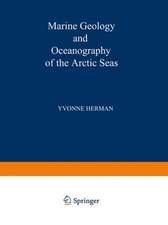Dynamical Oceanography
Autor Henk A. Dijkstraen Limba Engleză Paperback – 19 oct 2010
| Toate formatele și edițiile | Preț | Express |
|---|---|---|
| Paperback (1) | 395.47 lei 6-8 săpt. | |
| Springer Berlin, Heidelberg – 19 oct 2010 | 395.47 lei 6-8 săpt. | |
| Hardback (1) | 402.98 lei 6-8 săpt. | |
| Springer Berlin, Heidelberg – 16 ian 2008 | 402.98 lei 6-8 săpt. |
Preț: 395.47 lei
Nou
Puncte Express: 593
Preț estimativ în valută:
75.68€ • 79.37$ • 62.100£
75.68€ • 79.37$ • 62.100£
Carte tipărită la comandă
Livrare economică 01-15 aprilie
Preluare comenzi: 021 569.72.76
Specificații
ISBN-13: 9783642095252
ISBN-10: 3642095259
Pagini: 424
Ilustrații: XV, 407 p.
Dimensiuni: 155 x 235 x 22 mm
Greutate: 0.59 kg
Ediția:Softcover reprint of hardcover 1st ed. 2008
Editura: Springer Berlin, Heidelberg
Colecția Springer
Locul publicării:Berlin, Heidelberg, Germany
ISBN-10: 3642095259
Pagini: 424
Ilustrații: XV, 407 p.
Dimensiuni: 155 x 235 x 22 mm
Greutate: 0.59 kg
Ediția:Softcover reprint of hardcover 1st ed. 2008
Editura: Springer Berlin, Heidelberg
Colecția Springer
Locul publicării:Berlin, Heidelberg, Germany
Public țintă
ResearchCuprins
A first Impression.- Present Ocean Circulation.- Mathematical Description.- Vorticity.- Midlatitude circulation.- Wind-Driven Circulation.- Western Intensification.- Free Waves.- Stratification.- Adjustment.- Stability Of Zonal Flows.- Equatorial circulation.- Equatorial Ocean Circulation.- Dynamics of Enso.- Planetary circulation.- Thermocline Problem.- Antarctic Circumpolar Current.- Arctic Ocean Circulation.- Thermohaline Circulation.
Recenzii
From the reviews:
"This book is a must for any fluid dynamicist, physical oceanographer, coastal engineer, or physicist working with fluids. This clear, excellently written, comprehensive volume combines, in one place, all of the fundamental governing equations of fluid flow and ocean circulation. … The clarity of the writing … and the excellent, manageable problem sets at the end of each chapter make this a superb advanced undergraduate or graduate-level work for anyone working with large-scale fluid motion. Summing Up: Highly recommended. Upper-division undergraduate through professional collections." (B. Ransom, CHOICE, Vol. 46 (01), September, 2008)
“This well-organized and insightful textbook provides a very nice introduction to modern oceanography, especially ocean circulation in various parts of the globe, at a level appropriate to an advanced undergraduate, or introductory graduate course. Each chapter addresses a particular ocean feature of interest. … Each chapter concludes with a summary box, outlining the basic lessons learned, and a set of exercises that add extra detail to some of the model calculations.” (Peter Bernard Weichman, Mathematical Reviews, Issue 2011 i)
“‘Dynamical Oceanography’ is a textbook that introduces the reader to the subject by using a mathematically oriented approach that integrates elements of physical oceanography and geophysical fluid dynamics. Hence, the book is very attractive for students and researchers with a background in mathematics and physics and with an interest in ocean circulation. … A large number of figures, many in color, illustrate the material presented.” (Nina Kirchner, Zentralblatt MATH, Vol. 1214, 2011)
"This book is a must for any fluid dynamicist, physical oceanographer, coastal engineer, or physicist working with fluids. This clear, excellently written, comprehensive volume combines, in one place, all of the fundamental governing equations of fluid flow and ocean circulation. … The clarity of the writing … and the excellent, manageable problem sets at the end of each chapter make this a superb advanced undergraduate or graduate-level work for anyone working with large-scale fluid motion. Summing Up: Highly recommended. Upper-division undergraduate through professional collections." (B. Ransom, CHOICE, Vol. 46 (01), September, 2008)
“This well-organized and insightful textbook provides a very nice introduction to modern oceanography, especially ocean circulation in various parts of the globe, at a level appropriate to an advanced undergraduate, or introductory graduate course. Each chapter addresses a particular ocean feature of interest. … Each chapter concludes with a summary box, outlining the basic lessons learned, and a set of exercises that add extra detail to some of the model calculations.” (Peter Bernard Weichman, Mathematical Reviews, Issue 2011 i)
“‘Dynamical Oceanography’ is a textbook that introduces the reader to the subject by using a mathematically oriented approach that integrates elements of physical oceanography and geophysical fluid dynamics. Hence, the book is very attractive for students and researchers with a background in mathematics and physics and with an interest in ocean circulation. … A large number of figures, many in color, illustrate the material presented.” (Nina Kirchner, Zentralblatt MATH, Vol. 1214, 2011)
Notă biografică
Henk A. Dijkstra is professor of dynamical oceanography at the Institute for Marine and Atmospheric research Utrecht (IMAU) at the Department of Physics and Astronomy of Utrecht University, the Netherlands. After graduating in applied mathematics at the University of Groningen in 1984. During his Ph.D. he worked in Groningen on a Spacelab experiment involving Marangoni convection under microgravity conditions. From 1988-1990 he continued this research at the Department of Chemical Engineering at Cornell University (USA) . In 1990 he started to work on problems in physical oceanography at Utrecht University. His main research interests are in the stability of ocean currents and the physics of low-frequency variability of the climate system. He is the author of the book "Nonlinear Physical Oceanography" of which the 2nd edition appeared in 2005 (Springer).
Textul de pe ultima copertă
This textbook provides a mathematical introduction to the theory of large-scale ocean circulation and is accessible for readers with an elementary knowledge of mathematics and physics, including continuum mechanics and solution methods for ordinary differential equations. The book consists of four parts. Part I (chapters 1 - 4) is a very brief introduction to ocean circulation and the mathematical formulation of the governing equations of ocean flows. In addition, concepts are introduced that are necessary to describe and understand large-scale ocean currents. In part II (chapters 5 - 10), the theory of mid-latitude wind-driven ocean circulation is presented. The consideration of model development includes a top-down approach and reduced equations are derived using asymptotics and scaling. Part III (chapters 11 - 12) focuses on the understanding of equatorial currents and El Nino. In the last part IV, chapters 13 - 16, the theory of planetary scale flows is presented, covering topics such as the thermocline problem, the Antarctic Circumpolar Current, the stability of the thermohaline circulation and the Arctic Ocean circulation. At the end of each chapter several exercises are formulated. Many of these are aimed to further develop methodological skills and to get familiar with the physical concepts. A few exercises also serve to introduce extension topics. Fully worked out answers to all exercises can be downloaded from the book web site.








